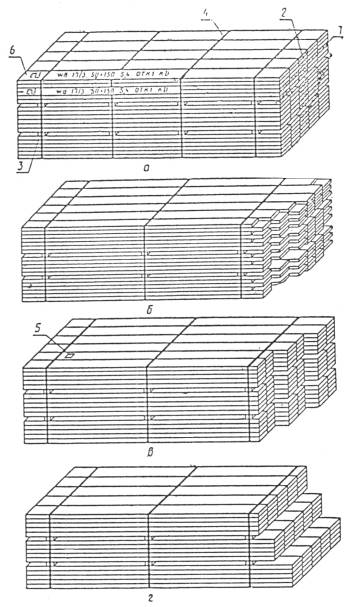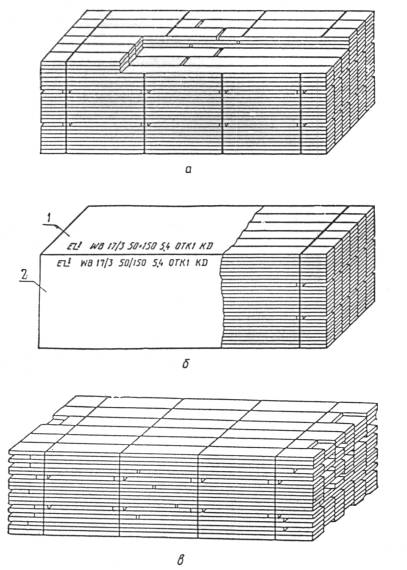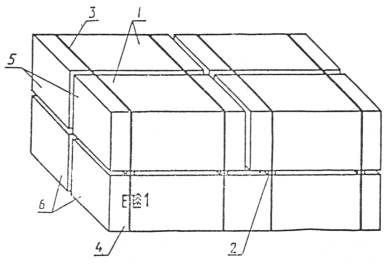+7 (495) 229-39-06 Moscow, Pevcheskij lane, house 4, str. 4
TRANSPORT PACKAGES
AND BLOCK PACKAGES PILOPRODUCTION
Palletizing, labeling,
transportation and storage
GOST 19041-85
(ST SEV 2373-80)
Moscow
IPK PUBLISHING HOUSE STANDARDS
1996
STATE STANDARD OF THE UNION SSR
Transportation packages and multi-packages of sawn timber. Packaging, marking, transportation and storage
Date 01/01/87
This standard applies to transport packages and block packages for the production of wood and hardwood intended for the needs of the national economy and export, as well as the requirements for their packaging, labeling, transportation and storage.
Standards do not apply to packages from obapol, from parts of wooden containers, from aviation lumber and blanks.
The definition of terms used in the standard is given in Appendix 1.
1. PACKING
1.1. The shape and size of the package and block package
1.1.1. The package and the package should be of rectangular cross section and have one or both aligned ends (Fig. 1-3).

1 - a row; 2 - foot; 3 - gasket; 4 - binding; 5 - label; 6 - marking
Heck one
It is allowed to use packaging with a conical shape of one end (Fig. 1c, d).

1 - marking; 2 - wrapper
Heck 2
When transporting lumber by rail, it is permitted to use trapezoid cross-section packages to fill the upper constricted part of the rail loading boom.
When forming a block packet, long packets are placed in the bottom row, short packets are placed only in the upper rows (Figure 3).
(Revised Edition, Rev. No. 3).

1 - packages; 2 - gasket; 3 - binding; 4 - marking; 5 - the top row of packages; 6 - bottom row of packages
Heck 3
1.1.2. The cross-sectional sizes of packages and block packages correspond to GOST 16369-88.
1.1.3. The length of the package and the packaging unit is determined by the maximum length of the sawn timber from which they are formed.
1.2. Packing composition and packing unit
1.2.1. Packaging must be packaged from sawn timber of the same grade, one width and thickness.
The note. Lumber belonging to the useless group is considered to be of the same grade.
The species composition of sawn timber packed in a package must comply with the requirements of the standards for this sawn timber.
With the consent of the consumer, stacking of lumber of different grades and width is allowed, provided that the same width of all rows in the package is kept the same.
1.2.2. The package is laid by sawing no more than four adjacent lengths.
It is allowed to stack timber in a package with splicing on length. At the same time in the extreme legs and two or three lower rows of the package stack lumber of maximum length without joining. When forming a package with docking along the length of thin lumber, lumber with a thickness of 32 mm or more is placed in one or two lower rows. In the middle part of the outer legs, with the exception of two or three upper and lower rows, it is allowed to stack lumber and billets through a row with splicing along the length (Fig. 2a, c). When forming a package of lumber, manufactured according to GOST 26002-83 and GOST 9302-83, splicing along the length is not allowed.When packing lumber for export, it is necessary to stack lumber of the same length. In agreement with the foreign trade association in the package can be stacked two or three adjacent lengths of lumber.
(Revised Edition, Rev. No. 3).
1.2.3. A block package must consist of packages of the same width and height belonging to the same shipment lot.
1.2.4. When packaging sawn timber with a thickness of 32 mm and more, in packages with a height of 850 mm and more there should be two rows of gaskets laid through 1/3 of the height, in packages less than 850 mm in height - one row of gaskets laid through 1/2 the height; when packing sawn timber with a thickness of less than 32 mm, respectively, three rows of gaskets through 1/4 of the height and two rows of gaskets through 1/3 of the height.
The thickness of the gaskets should be 10-25 mm, and the width - not less than 40 mm. In the same row should be laying the same thickness.
When packaging sawn timber, it is allowed to use sawn timber as a gasket, from which the package is formed, if its thickness and length do not exceed the dimensions of standard gaskets.
1.2.5. The number of gaskets in a row along the length of the package should be:
for packages up to 3, 75 m - 2 pcs .;
for packages from 3.9 to 5.5 m long - 3 pcs .;
for packages with a length of 5.7 and more - 4 pcs.
1.2.6. Extreme gaskets are placed from the ends of the package at a distance of 0.3-0.5 m - in packages up to 4.0 m long; 0.5-0.9 m - in packages longer than 4.0; the middle ones are approximately the same distance from each other and from the extreme ones. When several lengths are laid in a package of sawn timber in accordance with clause 1.2.2, the outermost gaskets are placed at a distance of not more than 0.3 m from the end of sawn timber of the smallest length.Sleepers laid in the package without pads.
(Revised Edition, Rev. No. 3).
1.2.3. A block package must consist of packages of the same width and height.
1.2.4. There are no lines and no lines, it’s less than 850 mm in height — one row of gaskets laid through 1/2 the height; and the rows of gaskets through 1/4 of the height.
The thickness of the gaskets should not be 10-25 mm, and the width is not less than 40 mm. Thickness of milk.
It is not necessary to make it that it is possible to use it.
1.2.5. The number of gaskets should be:
for packages up to 3, 75 m - 2 pcs.;
for packages from 3.9 to 5.5 m long - 3 pcs.;
for packages with a length of 5.7 and more - 4 pcs.
1.2.6. Extreme gaskets are placed at a distance of 0.3–0.5 m long; 0.5-0.9 m - in packages longer than 4.0; The middle ones are the same. When it comes to a timberline, it’s not possible to reach the smallest lengths.
Sleepers laid in the package without pads.
(Modified edition, Amendment No. 2).
1.3.2. The number of lines on the bag should be two.
1.3.3. The straps must be made of cold-rolled low-carbon steel, full-strength normal-precision tape according to GOST 3560-73, 20 mm wide and 0.5 mm thick with a temporary tear resistance of at least 600 N / mm2 or steel wire according to GOST 3282-74 4 mm in diameter temporary tensile strength of at least 300 N / mm2.
The number of straps on the package must be equal to the number of vertical rows of gaskets.
Binding should be located on the package in the placement of gaskets or near them at a distance not exceeding the width of the latter.
Depending on the type of connection of the ends of the tape, two types of straps are installed: with a seal and with a free-form joint.
The connection of the ends of the wire strapping is done by twisting its ends.
The tensioning force of the strapping must be at least 2000 N.
The ends of the single straps of steel tape and its substitutes should be pressed to the package and have a length of no more than 100 mm.
(Revised Edition, Rev. No. 3).
1.3.4. When forming packages of sawn timber, it is allowed to use bar-wire strapping. The harness consists of two wooden bars (top and bottom) with a cross section of 50´50 mm, the length of which is 100 mm greater than the width of the package, and two side wire screeds of wire according to GOST 3282-74 with a diameter of 4 mm in two threads. Packages 4-6.5 m long are fastened with three straps, shorter ones - with two. The two outer strapping set at a distance of 0.3-0.9 m from the ends of the package, and the third - in the middle of the package.
1.3.5. Steel wire straps and bar-wire straps are not used in the formation of saw packages for export.
1.3.6. It is allowed to use other strapping materials, according to their strength.
1.3.7. The control on compliance of the strapping with the requirements of this standard should be carried out by the supplier of sawn timber during the acceptance tests of packaged sawn timber packages. When this test is subjected to 5% of the straps of the total number, but not less than 6.
1.3.8. The check for compliance of the tension force with the requirement of this standard is carried out with an IN-400 device or by the amount of deflection when pulling with a force of 100 N in the middle of the side branch. The deflection should be no more than 10 mm at a length of 1 m.
1.3.9. Packing of sawn timber intended for the Far North and hard-to-reach areas - according to GOST 15846-79.
1.3.10. When shipping dry sawn timber (with a moisture content of no more than 22%), the package is wrapped with waterproof paper (Figure 2b) or waterproof paper or film is laid in the package under the upper row of sawing products).
2. MARKIN 2.1.
The package of sawn products must have a label with a size of 80´120 mm, on which the following details are applied with means ensuring the safety of marking:
name of the consignee;
name of destination;
name of the manufacturer or its trademark;
name of sawn timber with indication of grade (quality group), wood species, cross-sectional dimensions, mm;
the number of sawn products in the package or block package, m3;
designation of standard for sawn timber.
For sleepers, additionally indicate their type without specifying the size of the cross section.
The label should be made of fibreboard, paper or plywood, enclosed in a transparent waterproof envelope and fastened with wire or twine to the package in the most convenient, well-viewed places. An example of filling the label is given in the mandatory annex 2.
(Modified edition, Amendments No. 1, 3).
.2. The marking of the package of edged sawn timber for export should be applied on the top and side surfaces of the package on the right side of the flattened end at a distance of 75-100 mm from the top right edge and the end (see fig. 1a and 2b).
Marking is applied with indelible paint in one line, the height of letters and numbers is 100 mm. The distance between marks (sets of letters, numbers, symbols) must be at least 100 mm. In coordination with the consumer height of letters and numbers 45 mm are allowed. Permissible deviation in height marks +5 mm.
The marking of the package of unedged sawn timber intended for export should be applied on the label or on the upper row of the package at a distance of 75-100 mm from the right side edge.
Package marking must contain the following details:
trademark of V / O "Exportles" (Fig. 4);
batch number (bill of lading);
package number;
lumber cross-section, mm;
packet length, m;
technical control stamp;
stamp KD (information about chamber drying).
(Modified edition, Amendment No. 1).
2.3. Marking a block package of edged sawn timber should be applied on the side surface of the lower package at the level of 2/3 of the package height and at a distance of 150 mm from the end.
The height of the letters and numbers - 100 mm.
Marking a block package unedged sawn timber should be applied to a label that is attached to the side of the block package to its extreme strapping.
The label should indicate:
manufacturer's mark;
block number.
3. TRANSPORTATION AND STORAGE
3.1. Packed sawn timber is transported by all types of transport in accordance with the rules for the carriage of goods and the technical conditions for loading and securing goods approved by the Ministry of Railways.
(Revised Edition, Rev. No. 3).
3.2. Packages and block-packs of dry sawn timber during loading, transportation and unloading must be protected from precipitation.
3.3. Packages and block-packs of dry sawn timber should be stored in closed warehouses. It is allowed to be stored in open warehouses if the bags and block bags are protected with waterproof paper or film, or in cases where the stack of bags and the block of bags are closed by roofs and side shields.
3.4. The formation of stacks of packages and block packages of sawn products, the selection and preparation of the warehouse area must comply with the requirements of GOST 3808.1-80 and GOST 7319-80.
In closed warehouses, the height of the foundation must be at least 300 mm.

